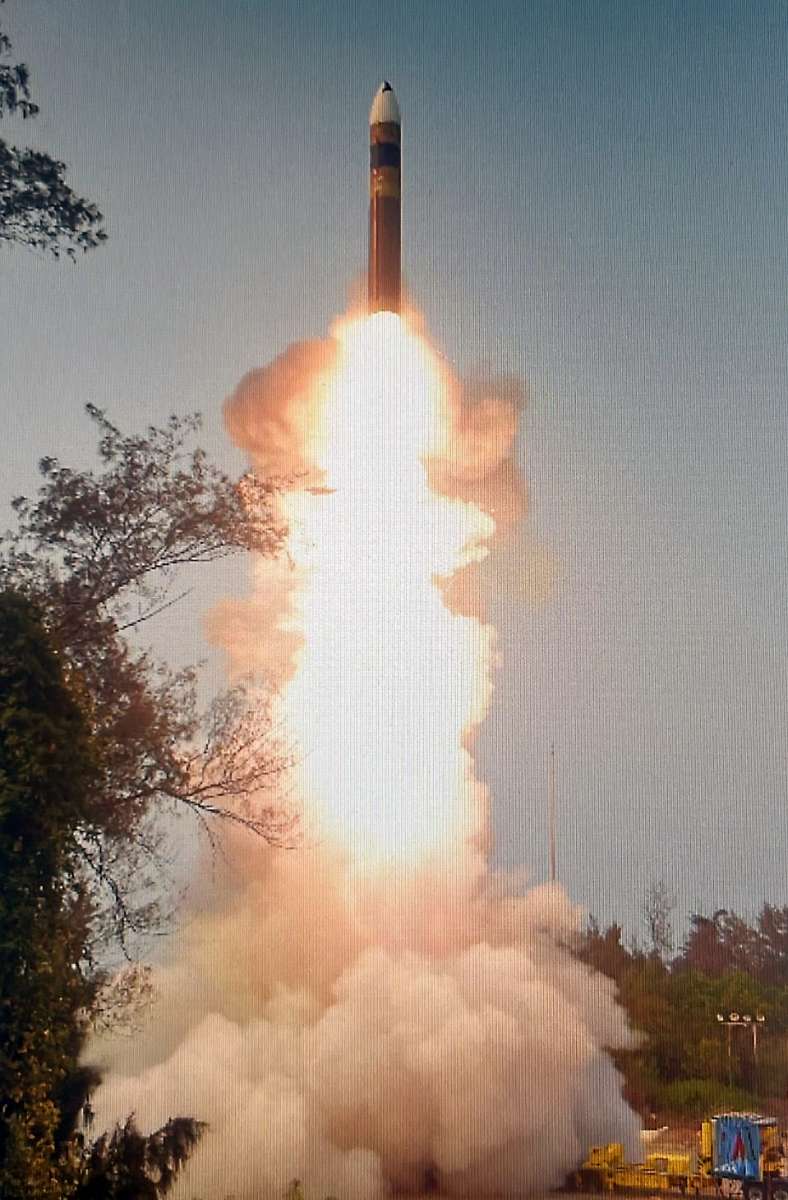The maiden flight test of Agni-V, India’s longest range ballistic missile with a “range of more than 5000 kms” was conducted in April 2012 and has since been tested multiple times…reports Asian Lite News
In a major technological breakthrough and building in redundancy into the country’s nuclear weapons programme, Prime Minister Narendra Modi on Monday announced the successful test firing of Agni-V ballistic missile with Multiple Independently Targetable Re-entry Vehicle (MIRV) technology by the Defence Research and Development Organisation (DRDO) under Mission Divyastra. The MIRV technology means a single missile can carry multiple warheads.
The flight test named Mission Divyastra was carried out from Dr A. P. J. Abdul Kalam Island in Odisha, DRDO said in a statement adding, “Various telemetry and radar stations tracked and monitored multiple re-entry vehicles. The mission accomplished the designed parameters.”
“Proud of our DRDO scientists for Mission Divyastra, the first flight test of indigenously developed Agni-5 missile with Multiple Independently Targetable Re-entry Vehicle (MIRV) technology,” Mr. Modi announced on social media platform ‘X’. Noting that with this test India has joined the select group of nations who have MIRV capability, Defence Minister Rajnath Singh too joined the PM in congratulating team DRDO.
This technology will ensure that a single missile can deploy multiple war heads at different locations, Government sources said noting that with Mission Divyastra, Government sources said. “This system is equipped with indigenous avionics systems and high accuracy sensor packages, which ensured that the re-entry vehicles reached the target points within the desired accuracy. The capability is an enunciator of India’s growing technological prowess,” sources said. “The project director is a woman and has significant women contribution.”
The maiden flight test of Agni-V, India’s longest range ballistic missile with a “range of more than 5000 kms” was conducted in April 2012 and has since been tested multiple times. It has also been canistered, which improves ease of handling and operation. Agni-V uses a three-stage solid fuelled engine and is capable of striking targets at ranges of over 5,000 Kms and can reach most parts of China. DRDO officials had stated over the last several years that MIRV tech was under development.
The first flight test of Agni V under Mission Divyastra marks a very important milestone in India’s march towards greater geo-strategic role and capabilities, President Darupadi Murmu said on ‘X’. “The state-of-the-art technology developed indigenously is a firm step in the direction of India becoming Atmanirbhar,” Ms. Murmu said congratulating Team DRDO for this major achievement.
Noting that as China undergoes a rapid expansion and modernization of its nuclear arsenal, today’s test shows India will not stand still, Dr. Clary added, “The question is the pace and breadth of China, India, and Pakistan’s combined arms efforts and whether the region–and India specifically–can avoid a costly arms race.”
Modi lauds first flight test of MIRV tech
Prime Minister Narendra Modi on Monday lauded Mission Divyastra, the first flight test of the indigenously developed Agni-5 missile equipped with Multiple Independently Targetable Re-entry Vehicle (MIRV) technology.
The Prime Minister praised the achievements of the Defense Research and Development Organization (DRDO) scientists for their successful execution of Mission Divyastra.
Taking to the micro-blogging site X, the Prime Minister posted, “Proud of our DRDO scientists for Mission Divyastra, the first flight test of indigenously developed Agni-5 missiles with Multiple Independently Targetable Re-entry Vehicle (MIRV) technology.”
The inclusion of Multiple Independently Targetable Re-entry Vehicle (MIRV) technology in the Agni-5 missile enhances its effectiveness in delivering multiple warheads to different targets with precision, thereby augmenting India’s deterrence capabilities and strengthening national security.

An MIRV payload involves a single missile carrying four to six nuclear warheads, each programmed to hit a separate target.
According to government sources, India today tested Mission Divyastra, the first flight test of an indigenously developed Agni-5 missile with MIRV technology.
This will ensure that a single missile can deploy multiple warheads at different locations.
According to government sources, the project director is a woman and has a significant women’s contribution. With the test of Mission Divyastra, India has joined the select group of nations that have MIRV capability.
This system is equipped with indigenous Avionics systems and high-accuracy sensor packages, which ensure that the re-entry vehicles reach the target points with the desired accuracy. The capability is an enunciator of India’s growing technological prowess, sources added.
Rajnath congratulates DRDO
Defence Minister Rajnath Singh on Monday congratulated the scientists of the Defence Research and Development Organisation (DRDO) for the maiden flight test of indigenously developed Agni-5 missile with Multiple Independently Targetable Re-entry Vehicle (MIRV) technology.
In a post on X, Rajnath Singh said, “India today successfully tested Mission Divyastra – the first flight test of indigenously developed Agni-5 missile with Multiple Independently Targetable Re-entry Vehicle (MIRV) technology and joined the select group of nations who have MIRV (Multiple Independently Targetable Re-entry) capability. Congratulations to our DRDO scientists and the entire team for this exceptional success. India is proud of them!”

